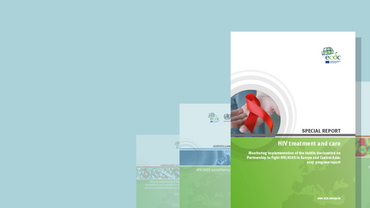HIV/AIDS Surveillance in Europe 2024 – 2023 data
HIV infection continues to affect the health and well-being of nearly 2.6 million people in the WHO European Region, particularly in the eastern part of the Region. This report is the latest in a series published jointly by the European Centre for Disease Prevention and Control (ECDC) and the WHO Regional Office for Europe that has been reporting data on HIV and AIDS in the WHO European Region and in the European Union and European Economic Area (EU/EEA) since 2007. It finds that while epidemic patterns and trends vary widely across European countries, nearly 113 000 people were diagnosed with HIV in the European Region in 2023, including around 25 000 in the EU/EEA.
This report presents HIV/AIDS surveillance data for 2023, which show significant variation in epidemic patterns and trends across the WHO European Region. In
2023, 112 883 HIV diagnoses were reported in 47 of the 53 countries in the Region, including 24 731 from the countries of the European Union/European Economic Area (EU/EEA). This corresponds to a crude rate of 12.7 HIV diagnoses per 100 000 population in the Region overall, a slight (2.4%) increase compared with the 2022 rate (12.4 per 100 000 population) but still a 19.6% decrease compared to the 2019 rate (15.8 per 100 000 population): the period before the coronavirus disease (COVID-19) pandemic. In all, 21 out of 47 countries reported an increase in HIV diagnoses in 2023 compared to 2022. Several countries, including Azerbaijan, Finland, Iceland, Ireland, Kazakhstan, Lithuania, Malta and Montenegro, recorded the highest number of HIV diagnoses in a single year over the past decade.
For the EU/EEA countries, the rate in 2023 was 5.3 per 100 000, marking a 15.9% decrease from the 6.3 per 100 000 rate observed in 2014. However, focusing only on newly reported cases and excluding previous positive diagnoses, the rate increased by 11.8% between 2022 and 2023 (from 3.4 to 3.8 per 100 000 population).
When comparing the number of HIV diagnoses made to the estimated number of new HIV infections acquired over the past decade, it is evident that an increasingly larger number of individuals are acquiring HIV infection than are being diagnosed. This indicates a growing number of people living with undiagnosed HIV in the Region. In the EU/EEA, the trend differs from that of the wider Region with slightly more diagnoses reported than estimated new infections.
The increase in HIV diagnoses in 2023 can be attributed to various factors across different subregions. In the east of the WHO European Region, countries reported a rebound in HIV testing and case detection since the COVID-19 pandemic subsided, focusing on increasing case detection and introducing new testing policies to
close the gap on undiagnosed individuals. In the EU/EEA and the west of the Region, the increase may be a result of increased diagnoses among migrants, particularly from high-prevalence countries, and expanded HIV testing services. In contrast, the number of HIV diagnoses in the centre of the Region decreased in 2023 compared to 2022, mainly due to a reduction in previous positive diagnoses. However, six out of 15 countries in the centre still reported an increase in 2023 compared to 2022.
Download








